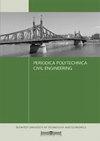孔洞对钢筋混凝土板抗弯承载力的影响
IF 1.4
4区 工程技术
Q3 ENGINEERING, CIVIL
引用次数: 0
摘要
钢筋混凝土空心楼板体系主要是在楼板底部放置聚酯泡沫。这些孔洞的目的是减轻板坯的重量。本文对空心钢筋混凝土板的受力性能进行了分析研究,其中空心位于板截面的中间高度。一系列的模型被创造出来,以达到一个轻量级的平板。采用ABAQUS软件对两种不同的板坯模型进行分析。在第一组中,楼板有三层,其中底层和顶层为实心钢筋混凝土,中层为空心无钢筋混凝土。在第二层,为了增加板的上下两层之间的接触,使用了交叉,并对中间层进行了相应的加固。由于各层厚度均为5cm,因此楼板的总厚度为15cm。石板宽100厘米,长200厘米。模拟了三点弯曲试验。混凝土采用混凝土损伤塑性材料模型(CDPM),钢采用弹塑性材料模型。结果表明,弯矩容量随孔洞体积的增大而减小。在没有交叉的情况下,空心板在达到屈服强度后强度突然下降。此外,交叉可以减轻楼板的重量,而不会显著降低弯矩能力。本文章由计算机程序翻译,如有差异,请以英文原文为准。
The Effect of Voids on Flexural Capacity of Reinforced Concrete Slabs
The voided reinforced concrete slab system is mainly produced with polyester foam placed mostly at the bottom of the slab. The aim of the voids is to reduce the weight of the slab. In this paper behavior of the voided reinforced concrete slabs in which voids placed at the mid-height of the slab cross-section, is examined analytically. A series of models were created to come up with a lightweight slab. Two distinct slab models were analyzed using the ABAQUS software. In the first group, slabs had three layers, in which bottom and top layers were of solid reinforced concrete, but the mid layer was of voided unreinforced concrete. In the second layer, in order to increase the contact between top and bottom layers of the slab, crossties were utilized, and the mid layer was reinforced accordingly. Since all the layers were 5 cm thick, the total thickness of the slabs were 15 cm. Slabs were 100 cm wide and 200 cm long. They were simulated the three-point bending test. Concrete damaged plasticity material model (CDPM) for concrete and elastoplastic material model for steel was selected. From the results it was found that moment capacity decreased with the increase in the volume of the voids. There was a sudden decrease in strength after reaching the yield strength in voided slab without a crosstie. In addition, crossties enabled the reduction of the weight of the slabs without significant decrease in moment capacity.
求助全文
通过发布文献求助,成功后即可免费获取论文全文。
去求助
来源期刊

Periodica Polytechnica-Civil Engineering
工程技术-工程:土木
CiteScore
3.40
自引率
16.70%
发文量
89
审稿时长
12 months
期刊介绍:
Periodica Polytechnica Civil Engineering is a peer reviewed scientific journal published by the Faculty of Civil Engineering of the Budapest University of Technology and Economics. It was founded in 1957. Publication frequency: quarterly.
Periodica Polytechnica Civil Engineering publishes both research and application oriented papers, in the area of civil engineering.
The main scope of the journal is to publish original research articles in the wide field of civil engineering, including geodesy and surveying, construction materials and engineering geology, photogrammetry and geoinformatics, geotechnics, structural engineering, architectural engineering, structural mechanics, highway and railway engineering, hydraulic and water resources engineering, sanitary and environmental engineering, engineering optimisation and history of civil engineering. The journal is abstracted by several international databases, see the main page.
 求助内容:
求助内容: 应助结果提醒方式:
应助结果提醒方式:


